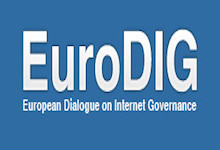EuroDIG 2017 – European workshop on policy watch activities: MAPPING project
8 Jun 2017 02:00h
Event report
The workshop, held as a pre-event to the EuroDIG meeting, was organised by members of the MAPPING project – Association for Technology and Internet (ApTI), DiploFoundation, and European Projects & Management (EPM) – as part of their work with the MAPPING Policy Observatory.
Ms Valentina Pellizzer, One World Platform, opened by explaining that the aim of the session is to discuss the questions and challenges that come up in the various digital policy observatory initiatives and other similar information gathering projects, and to identify best practices in the work of these initiatives. Mr Bogdan Manolea, ApTI, continued the introduction noting that the session builds upon an existing dialogue among observatories, which was formally launched at the Internet Governance Forum (IGF) meeting in 2014.
The session continued with an overview of various digital policy projects and initiatives, including:
- COMMUNIA’s copyright exceptions mapping, which documents the implementation status of copyright exceptions and limitations to copyright in EU member states.
- Geneva Internet Platform (GIP) Digital Watch initiative, which includes the GIP Digital Watch observatory (providing information on 43 Internet governance (IG) and digital policy issues: issues overview, policy updates, relevant actors, processes, events, instruments, and resources), the Geneva Digital Watch newsletter (which includes a round-up of developments and articles on various digital policy issues), and monthly GIP briefings on Internet governance.
- Global Information Society Watch, which has been mapping various digital policy issues over the years (e.g. access to infrastructure in 2008, access to online information and knowledge in 2009, communications surveillance in 2014, sexual rights in 2015, economic, social and cultural rights and the Internet in 2016. It is expected that the 2017 report will focus on community networks.
- Internet Legislation Atlas, acting as a map of Internet policies and a human rights watch in the Middle East and North Africa (MENA) region.
- Global Internet Policy Observatory (GIPO), an initiative launched by the European Commission in 2015 with the aim to monitor Internet-related policy, and regulatory and technological developments across the world.
- Internet governance developments in South Eastern Europe initiative, run by the South Eastern European Dialogue on Internet Governance (SEEDIG), in collaboration with DiploFoundation and the GIP. It includes monthly summaries of Internet governance and digital policy developments in SEE, as well a SEE hub for monthly Internet governance briefings.
The rest of the session was focused on exploring good practices in the work of these and other similar initiatives. Participants were divided into several working groups, each group exploring specific issues, and trying to map existing good practices. Groups then reported on their findings:
- Sharing and collaboration. The use of a common taxonomy of digital policy issues was identified as an example of a good practice in the work of policy observatories. It was also mentioned that, as observatories and other initiatives have different target groups, it might be difficult to talk about common approaches. However, a need was identified for a strengthened interoperability and collaboration among initiatives.
- Community building. Examples of good practices in building communities included: courses on digital policy issues, followed by activities aimed at keeping the network of alumni closely involved with the organisation providing the courses; fellowships for individuals to attend IG events and processes; involving community members in the work of the initiatives. A question that was raised and remained open was whether a community could be built behind an automated tool. One challenge in the work of observatories is related to the fact that experts might know more on a particular topic than the observatory itself.
- Interoperability. One area where observatories can share knowledge is the use of a common taxonomy (what is done, for example, by the GIP Digital Watch and the GIPO), which then allows a certain level of interoperability. The issue of a joint and regularly updated taxonomy should be further explored, for example, in the context of annual or bi-annual meetings.
- Data visualisation and interactivity. While it is acknowledged that there is a need for data visualisation, the main challenge is how to visualise data in a user-friendly, easy and inexpensive way. In order to be most effective, visualisations need to show interrelations and correlations among the issues they cover. Any such visualisation tools should be built not in silos, but through engaging the community and incorporating feedback from them.
At the end of the session, it was said that the dialogue among digital policy observatories and other initiatives should continue, with the aim of exploring more in depth both the challenges and success stories, and to avoid doing the same work twice.
Related event

